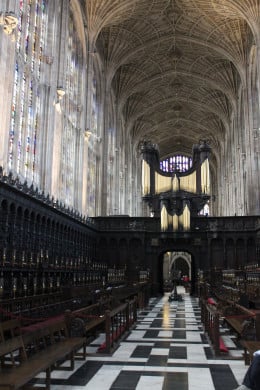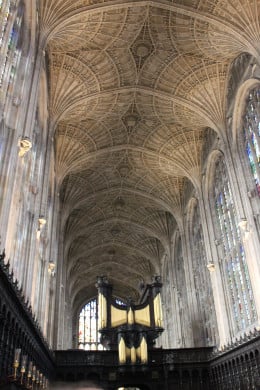King’s College Cambridge is best known worldwide for its magnificent chapel and its Christmas Eve carol service. The Chapel forms one side of the quadrangle of buildings at the College.
King’s College, is one of the 31 colleges which together form Cambridge University. King’s College was founded in 1441 by King Henry VI to provide accommodation for students from Eton to attend university. The students, mostly from privileged backgrounds, were bestowed degrees by King’s College without having to take exams.
Entry rules were relaxed by the mid-1500s to include students who had attended other schools.
Henry VI was determined that the chapel of his college would be the largest and most beautiful – the proportions of the chapel are the size of a cathedral rather than a chapel.
The Chapel
King’s College Chapel has been the venue for the BBC broadcast of the Christmas Eve service of Nine lessons and carols since 1956.
We were invited as VIP guests of the BBC for the 2012 Carols from King’s recording and mingled with producers and musicians at a pre-recording lunch at the Saltmarsh Room.
We were then escorted to the chapel and seated in the choir in the row behind the choir giving us the amazing experience of ‘being’ in the choir, hearing the individual voices of the singers in front of us, as well as the blend of voices from the choristers on the other side of the chancel, all in the soft light of the candles which created quite a magical atmosphere.
Architecture
The chapel is late gothic perpendicular architecture, with slender stone columns ascending what appears to be an impossible distance upwards and then fanning across the ceiling.
The fan vaulted ceiling is the largest in the world.
Reginald Ely, the first designer, was commissioned to work on the chapel in 1444.
The land where it stands was once part of the medieval river port town of Cambridge. Houses, shops and wharves were bought and demolished to make way for the college.
The original plan was to house a tutor and 12 poor students (the same number as the apostles) but Henry VI expanded the plans to accommodate 70 students.
The stone chosen was magnesian limestone from the College’s own quarry. Shortly after building began, the Wars of the Roses broke out, in 1455. Henry continued to give £1000 a year for the building work but when he was taken prisoner in 1461, the workmen abandoned the project.
By this time the foundations had been laid and the walls were being built.
Henry was murdered in 1471 at the Tower of London.
The following King, Edward IV, passed on some of Henry’s money intended for the chapel but only a little progress was made over the next 22 years until after Edward died.
His successor, Richard III, ordered that the work be continued and by the end of his reign, the first six bays of the Chapel were built to the full height, roofed with oak and lead and the chapel was being used.
Henry VII continued on with the work in 1508 and although he died the following year, he left £5000 and instructions for building work to be completed. By 1515 the structure was completed.
Henry VIII then oversaw the glazing and interior furnishings, the stained-glass windows, timberwork and the elaborate carved screen in the centre of the chapel. After more than 100 years, the chapel was finally completed.




Recent Comments